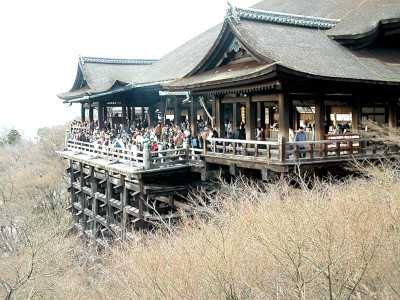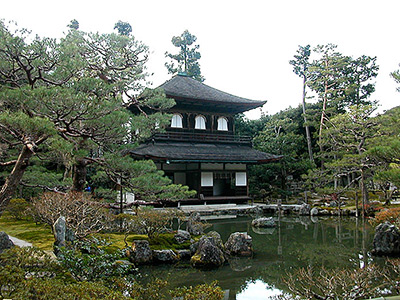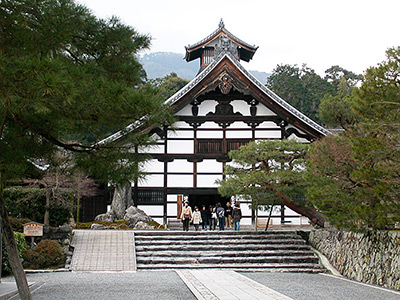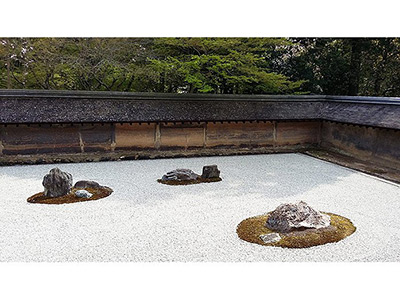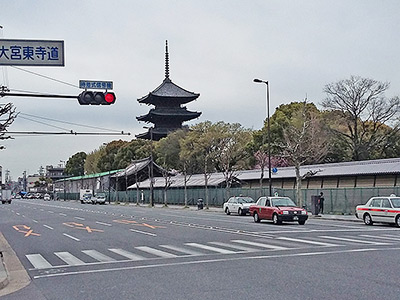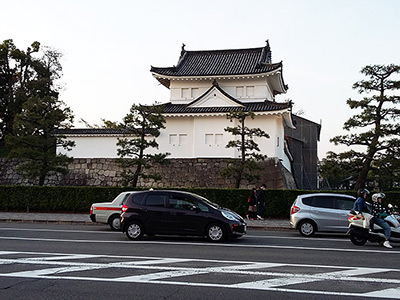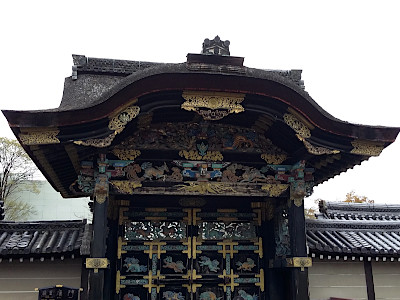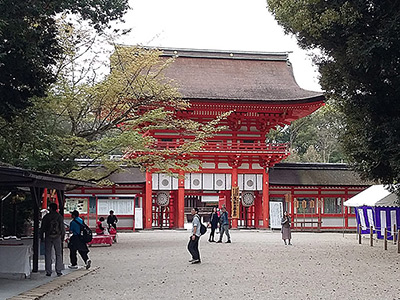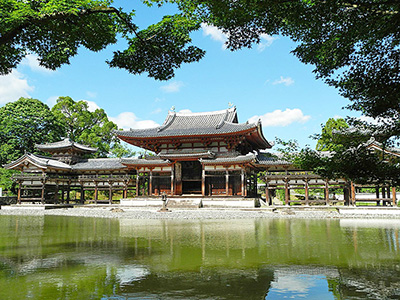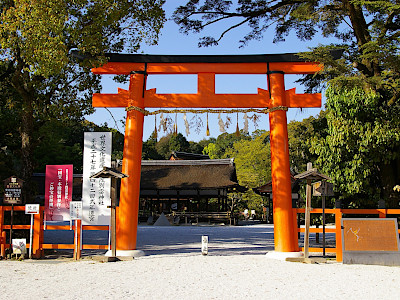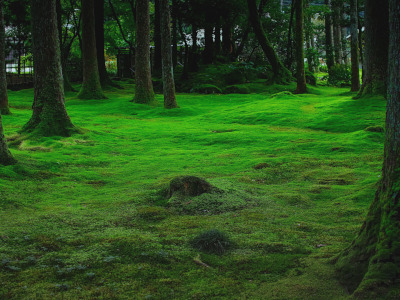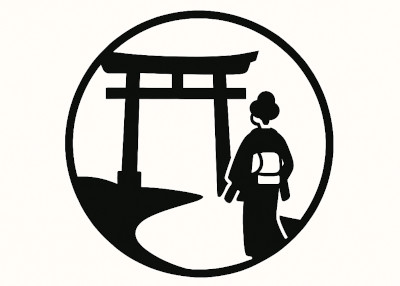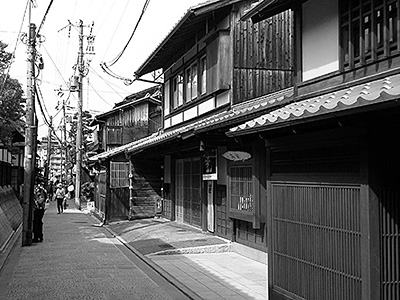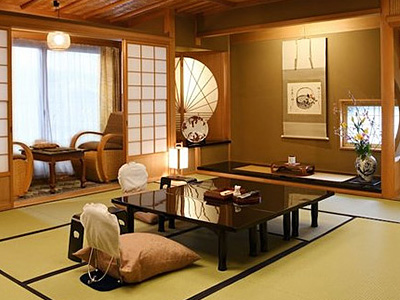17 UNESCO World Heritage Sites in Kyoto
This post can contain affiliate links, which means that we may receive a small commission if you make a purchase using these links.
Facts & Figures
Kyoto has a huge number of UNESCO World Heritage Sites, which are grouped under the label Historic Monuments of Ancient Kyoto. If you stay only for one or two days in the city it is nearly impossible to visit all of the 13 Buddhist temples, 3 Shinto shrines, and one castle. So far I have seen 13 out of 17 places and sorted them by my personal wow factor:) As a sidenote, this list is not covering all the sightseeing highlights in Kyoto. For example, the beautiful Fushimi Inari Taisha (Fushimi Inari Shrine), Nanzenji Temple, and Higashi Honganji Temple are not part of it. The World Heritage status was given to Kyoto in 1994.
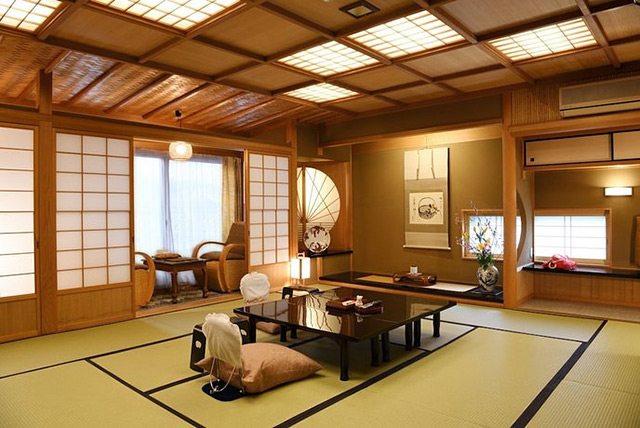 Experience the Ultimate Japanese Hospitality at a Kyoto Ryokan.
Experience the Ultimate Japanese Hospitality at a Kyoto Ryokan.
Find Your Perfect Ryokan Now >
- Overview of the 17 UNESCO World Heritage Sites in Kyoto:
- 1. Kinkaku-ji Temple (Golden Pavilion)
- 2. Kiyomizu-dera Temple
- 3. Ginkaku-ji Temple (Silver Pavilion)
- 4. Tenryu-ji Temple
- 5. Ryoan-ji Zen Temple
- 6. Toji Temple
- 7. Nijo Castle (Nijo-jo)
- 8. Nishi Honganji Temple
- 9. Ninnaji Temple
- 10. Shimogamo Shrine
- 11. Byodo-in Temple
- 12. Kamigamo-jinja Shrine
- 13. Daigo-ji Temple
- 14. Kokedera (Saiho-ji) Temple
- 15. Enryaku-ji Temple
- 16. Kozan-ji Temple
- 17. Ujigami-jinja Shrine
1. Kinkaku-ji Temple (Golden Pavilion)
Kinkaku-ji officially named Rokuonji Temple is a three-story building with a height of 12.5 meters. The two upper stories are completely covered in gold leaf. It is one of the most popular buildings in Japan and a perfect example of the construction style during the Muromachi period (1337 - 1573). Kinkaku-ji is also the most visited temple in Kyoto, besides Ginkaku-ji and Kiyomizu-dera.
Address: 1 Kinkakujicho, Kita Ward, Kyoto, 603-8361
Read More
2. Kiyomizu-dera Temple
Kiyomizu-dera or "Pure Water Temple" is one of the most famous and popular Buddhist temples in Japan. Kiyomizu-dera was founded in 778. The main hall with its wooden stage hovering 13 meters above ground is a masterpiece of Japanese temple architecture and a tourist hotspot. In 1994 the temple was added to the list of UNESCO World Heritage Sites.
Address: 1-294 Kiyomizu, Higashiyama-ku, Kyoto 605-0862
Read More
3. Ginkaku-ji Temple (Silver Pavilion)
Ginkaku-ji or its official name Jisho-ji (Temple of Shining Mercy) was built in 1460 as the retirement villa for shogun and art lover Ashikaga Yoshimasa (1436 - 1490). The architectural highlight is the two-story Kannon Hall (Ginkaku, Silver Pavilion). In the beginning, it was planned to cover the exterior of the hall in silver foil, but this plan was never realized. The last extensive restoration of the temple started in 2008 and was completed in 2010.
Address: 2 Ginakuji-cho, Sakyo-ku, Kyoto, 606-8402
Read More
4. Tenryu-ji Temple
In 1339 Tenryu-ji was built by shogun Ashikaga Takauji (1305 - 1358). Tenryu-ji Temple or "Heavenly Dragon Temple" belongs to the Five Great Zen Temples of Kyoto (Kyoto Gozan). This impressive head temple of the Rinzai Zen Buddhism School is truly a highlight within the Arashiyama district. Tenryu-ji Garden (Sogenchi-teien) belongs to the property and is one of the best and most beautiful gardens in Kyoto.
Address: 68 Susukinobaba-cho, Saga Tenryu-ji, Ukyo-ku, Kyoto, 616-8385
Read More
5. Ryoan-ji Zen Temple
Ryoan-ji (Peaceful Dragon Temple) in Kyoto belongs to the most famous Zen Temples in Japan. The reason for this status is its rock garden with 15 stones called Sekitei. In 1450 Hosokawa Katsumoto, a feudal lord, established the temple. The large Kyoyochi Pond at the temple grounds is also part of my best cherry blossom spots in Kyoto list.
Address: 13 Ryoanji Goryonoshitacho, Ukyo Ward, Kyoto, 616-8001
Read More
6. Toji Temple
Toji Temple (East Temple) also known as Kyo-o-gokoku-ji Temple, was founded by the Shingon sect in 794. The Buddhist temple is one of the oldest in Kyoto and is famous for its Five-storied pagoda. The height of the pagoda is 54.8 meters, which makes it the tallest wooden tower in Japan. The cherry blossom season (end of April) is the best time to visit this place.
Address: 1 Kujocho, Minami-ku, Kyoto, 601-8473
Read More
7. Nijo Castle (Nijo-jo)
Nijo Castle was the former residence of Tokugawa Ieyasu (1543 - 1616), founder and first shogun of the Tokugawa shogunate. The flatland castle complex includes the Ninomaru Palace and gardens, two concentric rings (Kuruwa) of fortifications, Honmaru Palace, and some support buildings. The palace was donated to the city of Kyoto in 1939 and the public got access to it in 1940.
Address: 541 Nijo-jo-cho, Horikawa-nishi-iru, Nijo-dori, Nakagyo-ku, Kyoto, 604-8301
Read More
8. Nishi Honganji Temple
Nishi Honganji (Western Temple) is one of the most important Buddhist temples in Japan and the headquarters of the Jodo-Shinshu (Pure Land Buddhism) sect´s Honganji branch. The construction of Nishi Hongan-ji began in 1591. Designated as National Treasures at the temple grounds are Amidado (Hall of Amida Buddha), Goeido (Founder's Hall), and Karamon (Chinese Gate).
Address: Hanayacho-sagaru, Horikawa-dori, Shimogyo-ku, 600-8501 Kyoto
Read More
9. Ninnaji Temple
Ninnaji serves as the headquarters of the Omuro school of the Shingon Sect of Buddhism. Emperor Koko (830 – 887) gave in 886 the order for the construction of Nishiyama Gogan-ji Temple. Ninna-ji belongs also to the most popular cherry blossom spots in Kyoto. In 1994 it received the status of a UNESCO World Heritage Site.
Address: 33 Omuro-ouchi, Ukyo-ku, Kyoto 616-8092
Read More
10. Shimogamo Shrine
Shimogamo Shrine, also called Kamomioya-jinja, is one of the oldest and most important Shinto Shrines in Japan. The shrine is dating back to the 6th century. The architectural style is considered to be the blueprint of Shinto Shrines all over the country. The East Main Hall (Higashi Honden) and West Main Hall (Nishi Honden) of the shrine are designated National Treasures and 53 shrine buildings have the status of important cultural properties.
Address: 59 Shimogamo Izumigawa-cho, Sakyo-ku, Kyoto, 606-0807
Read More
11. Byodo-in Temple
Byodo-in Temple is featured on the back side of the Japanese 10 Yen coin. The Byodo-in Temple is a striking representation of Buddhist Pure Land or Jodo architecture. The large and outstandingly beautiful Phoenix Hall (Hoo-do) is one of the only remnants of architecture from the Heian Period (794 - 1185). The Buddhist temple was built in 1052.
Address: Renge-116 Uji, Kyoto Prefecture, 611-0021
Read More
12. Kamigamo-jinja Shrine
Kamigamo Shrine (Kamigamo-jinja) was founded in 678 and is one of the oldest Shinto shrines in Japan.
The famous Aoi Matsuri (festival), one of the top three major festivals in Kyoto, is held here together with Shimogamo-jinja Shrine.
Address: 339 Kamigamo Motoyama, Kita-ku, Kyoto, 603-8047
Read More
13. Daigo-ji Temple
Daigo-ji is a Shingon Buddhist temple in Kyoto. The temple was built in 874 during the Heian period (794 – 1185). The large temple area contains many National Treasures of Japan like the Five-story Pagoda and Kondo Hall (Main Hall). The pagoda is one of the oldest buildings in Kyoto and dates back to 951.
Address: 22 Higashioji-cho, Daigo, Fushimi-ku, Kyoto, 601-1325
Read More
14. Kokedera (Saiho-ji) Temple
Kokedera (Saihoji) is a temple of the Rinzai sect of Zen Buddhism and can only be visited by application. Koke-dera means moss temple and describes the garden with its approx. 120 different varieties of moss. The temple has a history of over 1300 years.
Address: 56 Matsuojingatanicho, Nishikyo-ku, Kyoto, 615-8286
Read More
15. Enryaku-ji Temple
The UNESCO World Heritage site on Mount Hiei is one of the most influential monasteries in the history of Japan. It is also the headquarters of the Tendai sect of Japanese Buddhism. Enryaku-ji was built in 788 during the Heian period (794 – 1185).
Address: 4220 Sakamotohonmachi, Otsu, Shiga 520-0116
16. Kozan-ji Temple
Kozan-ji or Kosan-ji was founded by Japanese Buddhist monk Myoe (1173 - 1232) during the Kamakura period (1185 – 1333) in 1206. The Buddhist temple belongs to the Omuro sect of Shingon Buddhism. The temple complex contains many important cultural properties and national treasures.
Address: 8 Umegahata Toganoocho, Ukyo-ku, Kyoto, 616-8295
17. Ujigami-jinja Shrine
Ujigami-jinja Shrine dates back to approx. 1060. In 1994 it received the status of a UNESCO World Heritage Site. The architectural style of the shrine is called nagare-zukuri. The honden (main hall) and haiden (hall of worship) have the status of a National Treasure.
Address: 59 Yamada, Uji, Kyoto, 611-0021


